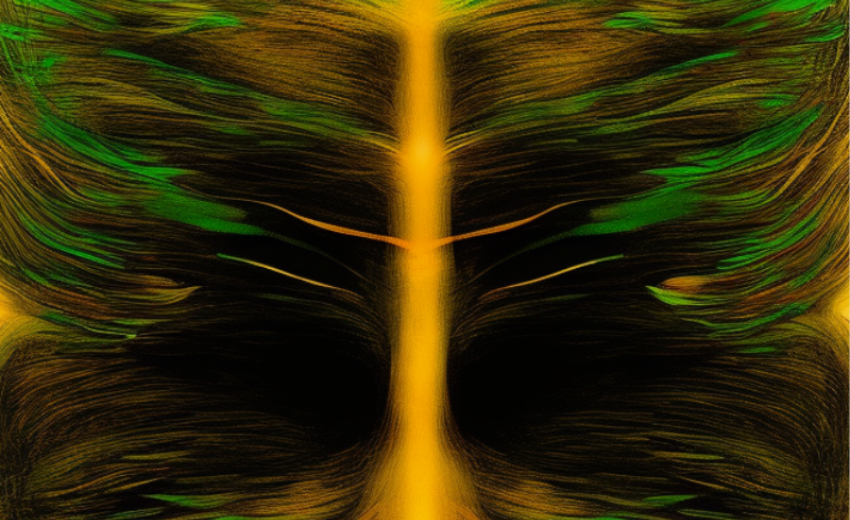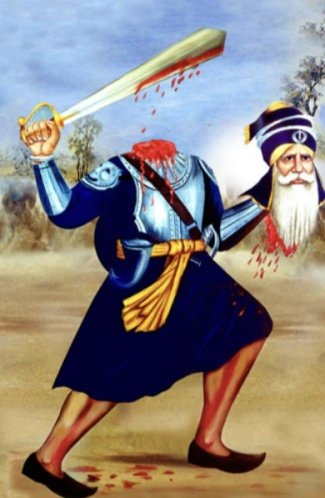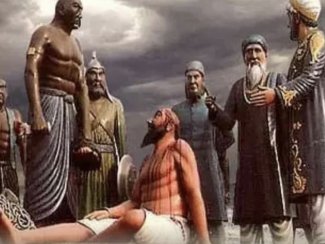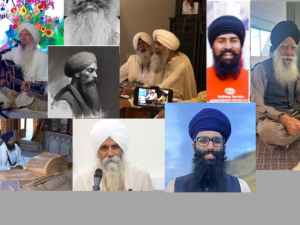Chardi Kala is the priceless concept of the high spirit of the Sikhs. It is a term for aspiring to maintain a mental state of eternal resilience, positiveness and satisfaction; an acceptance that life ebbs and flows with hardship and to rise above that adversity.
Chardikala is a bold concept in which self-restraint, determination, faith in God, living in God's will etc. even during times of suffering. It is the luminous brightness of the mind. Sikhs are ideally expected to be in this positive state of mind as a sign of their contentment with the will of God. It is also described as being in "high spirits" or a "positive, buoyant and encouraging" attitude to life and to the future.
It is the state of mind in which a person has no negative emotions like fear, jealousy or enmity. Instead the mind has many positive feelings including joy, satisfaction and self-dignity. Chardikala is one such language of Khalsa which seems to have been invented in the seventeenth-eighteenth century. Sikhs believe in the will of God . They also believe that God is without enemies (nirvair), and is always merciful. Hence, humans should accept his will even at times one suffers severe hardship and strive to work through it, to the betterment of others.
The scope of meaning of this concept is wide. In this concept of never fearing the enemy, the application of fighting the battle with faith is basically a process of thoroughgoing and steadfast iron-mindedness. The concept of Chardikala makes the warrior Sikhs rise and fall from time to time and reveals a balance point in the process. Thus, faith in the Akal Purakh and attitude allow one to face hardships with as little harm as possible. This also involves joining and helping others in their hour of need.
"Nanak Naam Chardi Kala,
tere bhane sarbat da bhala"
The indomitableness of Chardikala with a firm belief in triumph is indicated and the whole process of war is revealed. To go to the root of this concept, one has to accept death first and by taking the oath of victory over death, it becomes a joyous celebration for the warrior . The use of analogies for inter-mind confrontation at many places in Gurbani, in fact the direct mention of the war zone is a symbol of the Chardi kala:
ਜਉ ਤਉ ਪ੍ਰੇਮ ਖੇਲਣ ਕਾ ਚਾਉ ॥
ਸਿਰੁ ਧਰਿ ਤਲੀ ਗਲੀ ਮੇਰੀ ਆਉ ॥
ਇਤੁ ਮਾਰਗਿ ਪੈਰੁ ਧਰੀਜੈ ॥
ਸਿਰੁ ਦੀਜੈ ਕਾਣਿ ਨ ਕੀਜੈ ॥੨੦॥
Jo to prem khelan kā chão.
Sir dhar tali galī merī ā-o.
It marag pair dharījai.
Sir dījai kān na kījai. ||20|| ( SGGS. 1412)
(If you desire to play this game of love with me, then step onto My Path with your head in hand. When you place your feet on this Path, give Me your head, and do not pay any attention to public opinion)
Bhagat Kabir ji has expressed the mental combative nature of Chardi Kala:
ਸੂਰਾ ਸੋ ਪਹਿਚਾਨੀਐ ਜੁ ਲਰੈ ਦੀਨ ਕੇ ਹੇਤ ॥
ਪੁਰਜਾ ਪੁਰਜਾ ਕਟਿ ਮਰੈ ਕਬਹੂ ਨ ਛਾਡੈ ਖੇਤੁ ॥੨॥੨॥
Sūrā so pahichānī ai jo lare deen ke het.
Purjā purjā kat marai kabhū na chhādai khet.(SGGS. 1105)
(He alone is known as a spiritual hero, who fights in defense of religion.
He may be cut apart, piece by piece, but he never leaves the field of battle.)
Sri Guru Arjan Dev Ji was made to sit on the hot iron cauldron but Guru Sahib did not accept inequity. The tyrannical government of that time had realized that one day this martyrdom would be dedicated to the welfare of mankind, the revolutionary movement, and the political building and construction made with the destruction along with the tyrannical rulers. Sri Guru Hargobind Sahib Ji had to cut through the thorns of oppression to fulfill this concept and Sri Guru Teg Bahadur Sahib Ji had to martyr himself in Chandni Chowk of Delhi after getting the honor of "Shristi di Chadar". He freed the Indian people from the fear of death and lit the lamp of fighting and dying for the sake of religion. This was the next phase of Miri-Piri's philosophy of life. Guru Gobind Singh ji had to dig up the roots of oppression and had to hold a sword in hand. Khalsa for many centuries passed through the unbearable tortures by the timely rulers but there was no difference in the tests and molded gold (Khalsa Panth) creates a unique luster. In this way, the glory of the Sikh community has never faded .
The ten Gurus had to go through terrible struggles during the hectic journey . For centuries, the Khalsa has been drinking the halahal (terrible poison) of deadly blows for the good of the whole world. Whenever foreign forces came into conflict with the Sikhs, it was inevitable and natural that a great struggle would begin. The onslaught of foreign invaders on the soil of the Punjab tried to crush under their wheels but the Sikhs were the only nation in India that stopped the blood thirsty raiders with a rock-like determination. Guru Gobind Singh ji with the indelible influence of his prophetic and supernatural personality inspired millions of people with the inspiration and enthusiasm to fight the struggle of life with "Nirbhau Nirvair" for all time through this concept:
Chu Kar Az Hama Hilte Dargust
Halalhast Burden ba Shamshir Dast.
( Zafarnama. 22)
In a single line of "Zafarnama" there is evidence of Guru Sahib's skill and fearlessness. Sri Guru Gobind Singh ji's important point in the wars/battles was the concept of Chardikala , due to which a handful of Singhs uprooted the feet of the enemy forces numbering in lakhs. It was courage, bravery and military acumen that set the feet of enemies on edge. These qualities of the Singhs are immortal memories in the military history of the world. Bhai Taru Singh's example lit the way by becoming a beacon of light in the weakened people. Due to this concept, many directions of devaluing of human values were revealed later in the long struggle of Sikhs and the concept of Chardhikala won victories in fierce battles on religious, cultural and social levels.
Bhai Sukha Singh and Bhai Mehtab Singh cut off the head of Massa Ranghar. In the fort of Sri Anandpur Sahib, a small number of Singhs, who are as brave as Sri Guru Gobind Singh Ji, are besieged by Mughal forces and hill kings. The enemy sends a drunken elephant to the gate of the fort. Duni Chand is chosen by Guru Sahib for the elephant competition, but Duni Chand, disobedient to the principles of the Khalsa, barren and dwarfed, goes home and dies a shameful death, but warrior Bhai Bachitar Singh, the embodiment of excellence, is a historical figure.
There is readiness for action and the statement of the Khalsa fulfills the historical truth with action.The historical events of the Khalsa in the 18th century, when they were alive, are full of the concept of ascendancy. When Baba Banda Singh Bahadur's eyes were removed, he saw the urns of the Khalsa state emerging. There was a sound and it seemed to be ringing when Babaji's hands were removed , it seemed to him that swords were brandishing in many hands. When Nadarshah was plundering Hindustan, a handful of skilled Singhs took away his wealth and treasure.
Chardikala is the cultural treasure of the Khalsa Panth which is exclusive and unique. The history of Sikhs is replete with the charisma of the Chardikala . Sikh Holocausts, Akali movements, Guru ka Bagh Morcha , Ghallughara June 1984 and current sectarian conflict, yesterday and today. The concept of Chardikala and the desire to die fighting in unity, patience and the spirit of sacrifice towards each other. It is only the stalwarts of the Chardhikala, who hover like a raft of river water in the flood of pressure and take away the obstructions in the way. The sacrifice given for the fulfillment of true diligence and perseverance fills a person with steadfastness and like the lions and the seriousness like the sea. There was also a time when the value of Sikh heads increased, but in those times, Sikh warriors worshiped the concept of Chardikala while living with the inner warmth of the mind. The concept of independence in the face of the Chardhikala , the power of the Khalsa gradually came out and became a developmental nature. The fire of Chardhikala was not tolerated. This concept later makes the young Khalsa the source of inspiration for the militant solution to the imperial interest of humanity. If a child, a man, or a woman keeps his head on the Palm and joins the family of the Khalsa by being molded in the bunch of truth, then the mind does not wobble, and the head does not shatter.
Sikh history tells that whenever the struggle of the ebony people against humanity flared up, new chapters were added to the ethical interpretation of the appropriation of the Chardhikala . The concept of Chardikala not only provided broad guidelines for the coming generations of the Khalsa, but also expanded the point of this concept. That is why Sikh martyrdom is unique in the world: it has a unique combination of virtue and sunshine, misery and courage.
Chardikala is the legacy of the Singhs, the ember of sacrifice, the symbol of pride. The Khalsa always kept abreast of the new truth. The Khalsa's vision of self-empowerment awakens the Khalsa human group to the goal of self-management. Humanity's militant struggle for self-determination is the path of the Khalsa's concept of ascendancy:
ਚਿਹ ਮਰਦੀ ਕਿ ਅਖ਼ਗਰ ਖ਼ਮੋਸ਼ਾਂ ਕੁਨੀ ॥
ਕਿ ਆਤਿਸ਼ ਦਮਾਂ ਰਾ iਫ਼ਰੋਜ਼ਾ ਕੁਨੀ ॥੭੯॥
Chew mardi ki akhgar khamoshan kuni,
Ki atash daman ra b-doshan kuni ( Zafarnama. 79)
(What manliness you have shown by extinguishing a few sparks (sahibzadas). You have made the conflagration brighter and more furious.)








